Sightings and a Plumed Seed
Summary
My perspective on art and its potential is to create a sense of community and connection between urban and rural environments using art as a unifying force. Art has been a significant aspect of human culture throughout history, and it has the power to bring people together, regardless of their backgrounds or origins, if the willingness is there. It is a great platform to explore sustainability as a base to care for and honour Mother Earth and work toward a cleaner, environmentally friendly world.
My passion for plants has led me to base my artistic practice on spent plants. I am interested in the physical, the mechanics aspects within botany, a combination of subjects known as biophysics. I document images of three plumed seeds of the Asteraceae genre of plants to show the variation in their structure within this family.
My research has taken me on a fascinating journey allowing me to blend my artistic expression, scientific inquiry and observation of the natural world, weaving together a wealth of ideas and exploration. The combination of sculpture, drawings, poems and biophysics allows for multidimensional and thought-provoking documentation within my creative practice.
I include a poem from my field observation where I describe a sighting of a plumed seed falling to the ground at 45 degrees. A sighting in nature is witnessing an event like a swarm of bees or animal migration that is a seasonal occurrence. Sightings can be observed amongst plants such as the action of a Venus flytrap and the blooming of the Tragopogon pratensis (common name Salsify) opening and closing its flower within a few hours and not opening again until it forms a globe/clock of seeds a few days later. Leaves falling, maple seeds pirouetting and thistle plumes bobbing as they dance with the air are all sightings in nature. I have always classed my sightings as in the same category as an Art Happening because they both give the same sense of wonderment, an awareness or connection as if tapping into a new sense. (For more information on my thesis please go to Happenings, Sightings and a Plumed Seed).
Key words: Art and science, sculpture, drawing, plumed seed, sustainability, plant morphology, environment and poetry.
Additional info
Claire McDermott is a multidisciplinary artisan, who uses oral Irish knowledge of the land, together with science to research spent plants. Her sculpture explores social and environmental concerns through costumes and artefacts. She uses macro photography to capture the essence of nature, while her drawings are her method to formulate the data of her thinking.
She graduated with a HND in Design: Historic Decorative Crafts at De Montford University, Lincoln 1996 and she started reading biophysics after a visit to CERN during her Masters at Central Saint Martins (CSM), UAL 2020. During her Master of Research (MRes) in Fine Art and Humanities at the Royal College of Art in 2023, she was included in two poetry publications, which are based on her field observations and biophysics to articulate the function and mechanism of the morphology of a spent flower. She was awarded funding by Arts Council, England, UAL’s Student Union, and The Gane Trust. Mc Dermott’s microscopic hand-painted illustrations are held at Cill Rialaig Arts Centre, Ireland; her public sculpture ‘The Meeting Tree’ is installed at Newton Farm Ecology Park, London. She has exhibited at Tate Exchange, Watford Museum, University College London Hospitals, Cooke Latham Gallery, and Beaconsfield Gallery.
All photographs, drawings and sculptures are by Claire Mc Dermott and are protected by copyright.
Poem titled: Lazy Day
On one of those warm lazy days when sun cream and sunglasses are the norm,
You may see the birds way up high,
Stretching out their wings and aimlessly gliding around and around in the air currents.
A bird’s paradise, a playground in the celestial sphere.
They draw circles in the sky while soaring on the thermals.
Thermals that are created by the meeting of the different temperatures of air,
That converge and push against each other creating an upward movement,
rising way up high in the sky.
*****
Here the birds only need the occasional few flaps of their wings,
To align themselves back into their column of air,
As they effortlessly climb the transparent spirals.
This rising air comes from the earth and reaches up into the wild blue yonder,
Sometimes the currents are slow and leisurely,
And that can be heard but weirdly cannot be seen,
Other times they can materialise into wiped-up currents to form violent tornados,
Where beasts, birds and humans hold hard onto life.
*****
On one of those warm lazy days I had my two feet on the ground as I have no wings to play.
The birds seemed to be not letting on to us that they really are in paradise.
Horizontal wings while tipping from side to side,
Working up the column of air in their roundabout way.
Not letting us know that they are floating,
In the larder that is potently full of pollen, seeds, and bugs,
Ready to be gorged.
*****
On this day my eye caught something moving fast in my peripheral vision.
It was a plumed seed that must have risen on the wind and had possibly ridden a thermal or two.
And now was spectacularly soaring past me, paring downward at 45 degrees to the ground.
It was moving so fast my eyes could just about keep up with it,
I swivelled my head but that was not enough,
So I turned my body 180 degrees by pivoting on one foot,
As its descent spread over forty feet or more.
*****
I knew by the shape of the plumes that I was seeing a dandelion seed cruise by.
My vision allowed me to clearly see the outdoor space,
And my long term memory still recalls the landscape to this day.
As it got further away I could only see the v shape of the pappus plumes,
As the beak (stem) and seed were now too small to see.
*****
20/20 vision or 6/6 vision
This means you can see 20 feet or 6 meters away, imperial or metric.
But how much did I really see?
I acknowledged it because I recognised it,
My brain told me I was seeing it,
And yet this was my first notable sighting of a plumed seed soaring,
Through the air at 45 degrees.
How do I know now what I really saw?
Did I see the seed attached to the beak and the plumes or did I just see the plumes?
*****
The trajectory is the answer to my thoughts,
The trajectory of the plumed seed tells me how it flew without even seeing it,
Tt would have flown a different flight if it did not have its beak or seed.
Without the seed to slice through the air and guide the glider in,
There would have been no 45 degrees fast-descending flow.
Without the seed, it would have been a downward fall,
Soft and light, possibly spinning and defiantly vibrating,
On this warm summer’s day this seed was the one that descended in a specular style.
From the playground of the inner surface of our beautiful sphere.
*****
On one of those warm lazy days, I had my two feet on the ground as I had no plumes to fly.
The seed was now out of sight as a bush obscured my view,
But I knew it had made it and hopefully, the seed had driven itself into the soil or a tiny ravine.
Research shows that if the seed, beak and plume drives itself into the soil and remain intact,
Then its germination is faster and the yields are higher,
Compared to the seeds without its plumes.
*****
If no anchorage is found by the seed,
It may roll around on its plumes with the possibility of a second take-off, a second flight,
And return hopefully with a rocket-style entry into the soil,
For germination to begin, for the next generation to take to the wind.
To grow into a fluffy dandelion globe and wait for another lazy warm day,
Waiting for that puff of air to whisk the dandelion seed,
way up high,
To the playground in the sky.
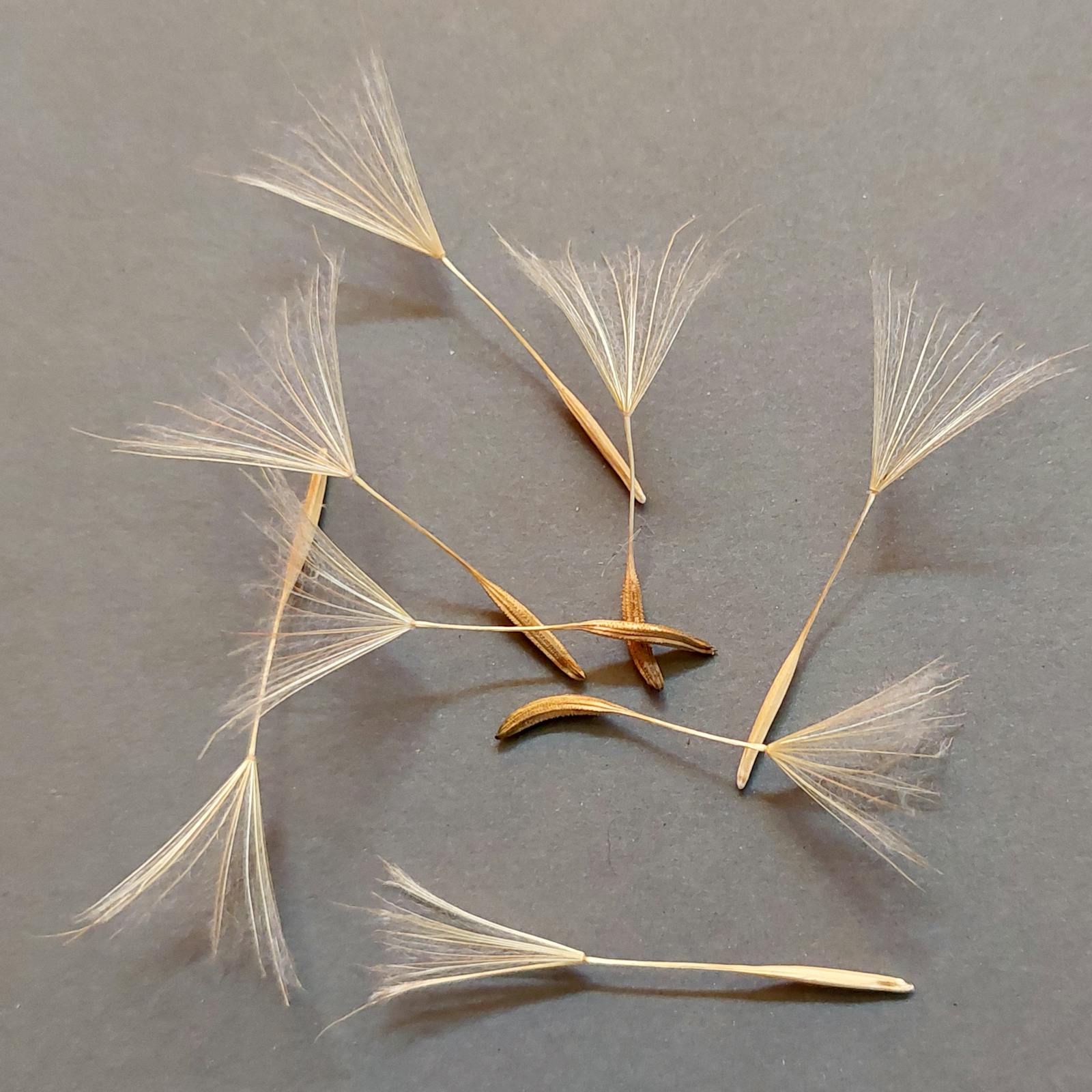
Plumes, beak (stem) and seed of a Salsify. Material: Photograph. Size 2.5h x1.5w cm, Year 2023
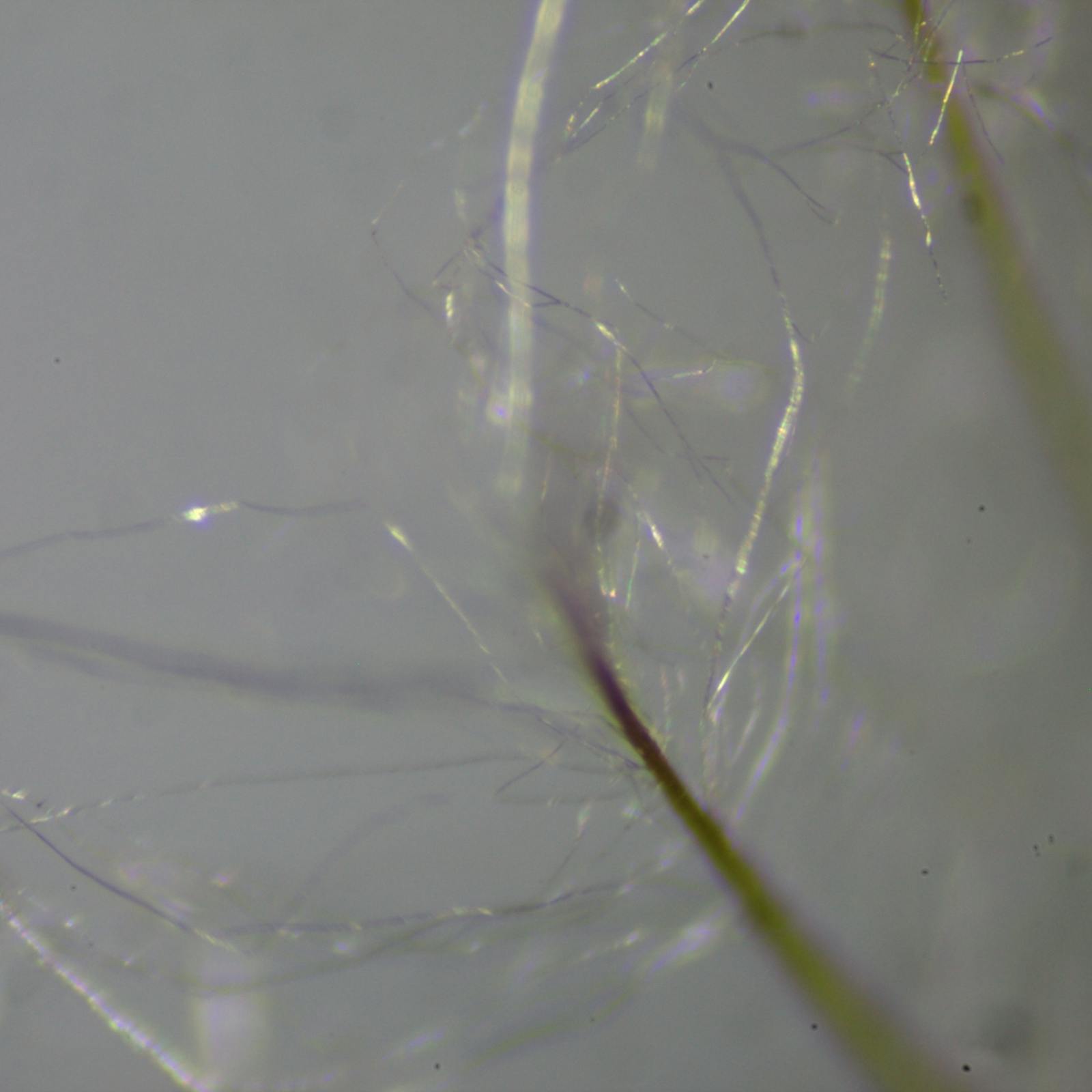
Magnifying image of the tip of the plumes of a Salsify. These secondary plumes resembled glass which inspired me to use it as a material in my work. Material: Photograph. Size 2.5h x1.5w cm. Year: 2023
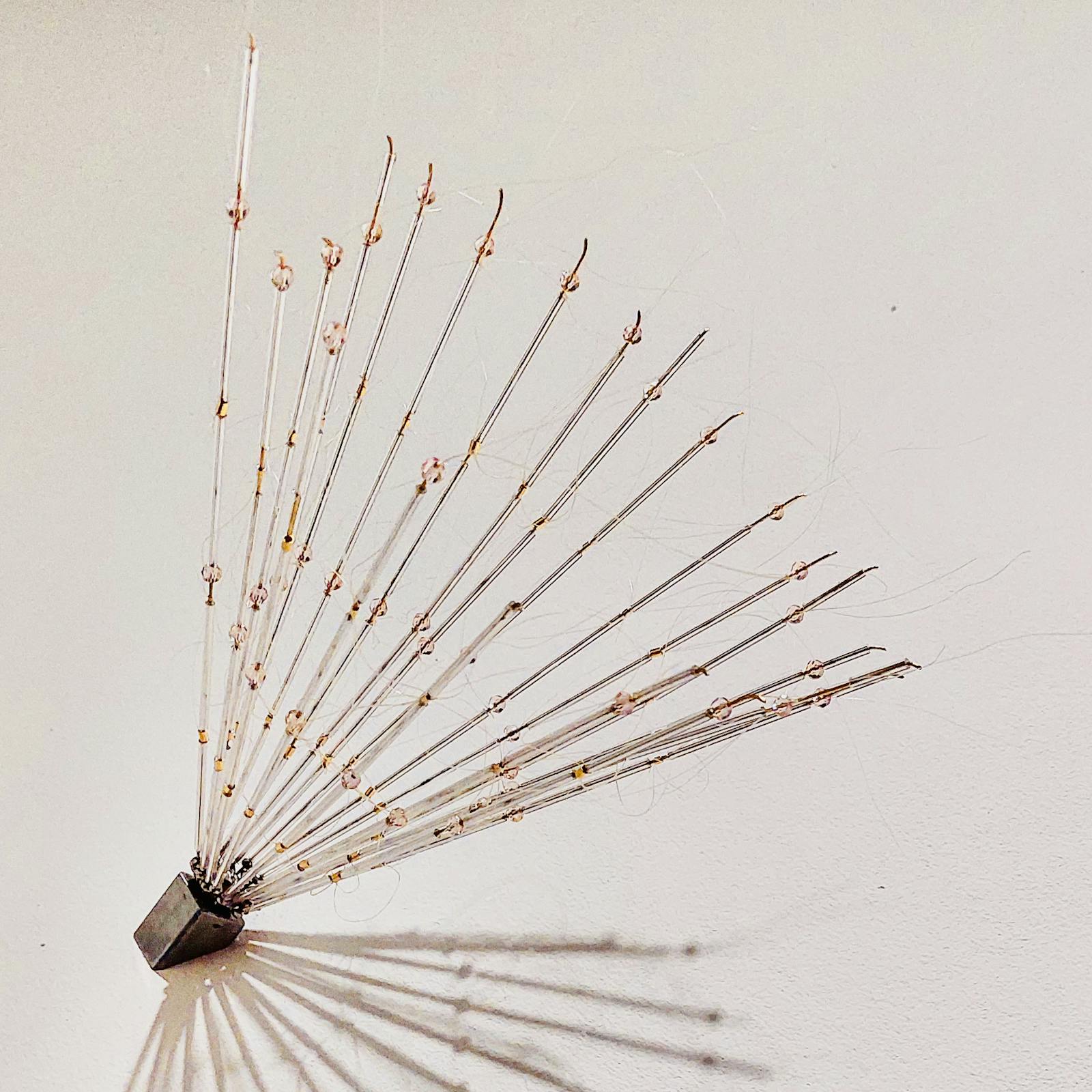
Photograph of this beaded sculpture was inspired by my microscopic observation of the plumes of the Tragopogon pratensis (common name Salsify). Exhibited at Cooke Laytham Gallery. Material: Metal, beads and hair. Size: 20h x 25w cm. Year: 2023

Plumes, beak (stem) and seed of a Dandelion. Material: Photograph. Size 2h x 1.5w cm. Year: 2023

The painting shows the centre of an Aster (common name Michaelmas daisy). It is just starting to become a spent flower. It shows the arrangement of the florets, and the white lines of the plume seeds are just starting to show. Material: Water colour. Size:30h x 30w cm. Scale 1/16. Year: 2015.
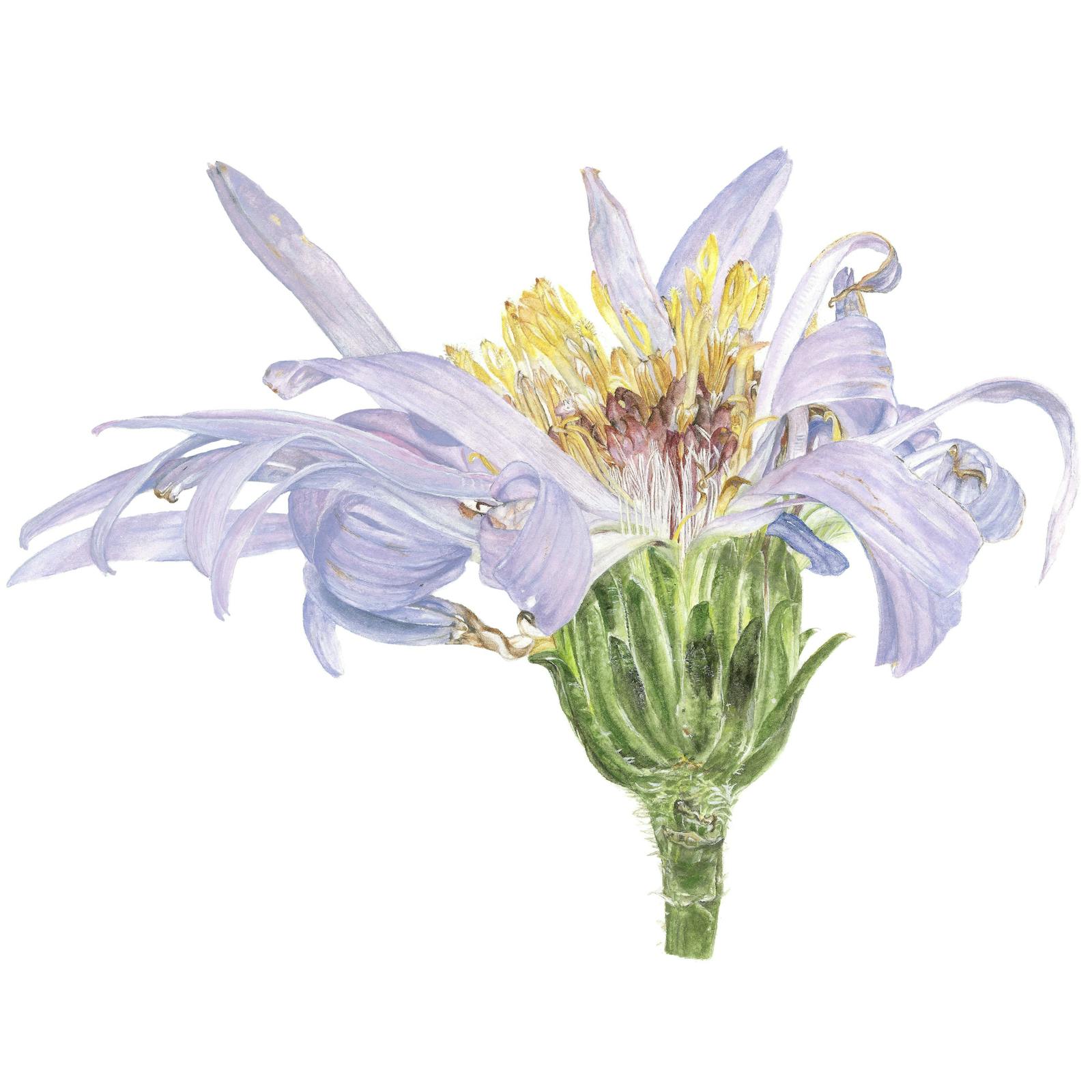
The paintings show the centre of the spent flower crammed with opening florets, packed full with enormous energy and forcing the structure of the flower head into a concertina movement while appearing to be motionless.
Dimension 30h x 30w cm Scale 1/16. Year 2015.
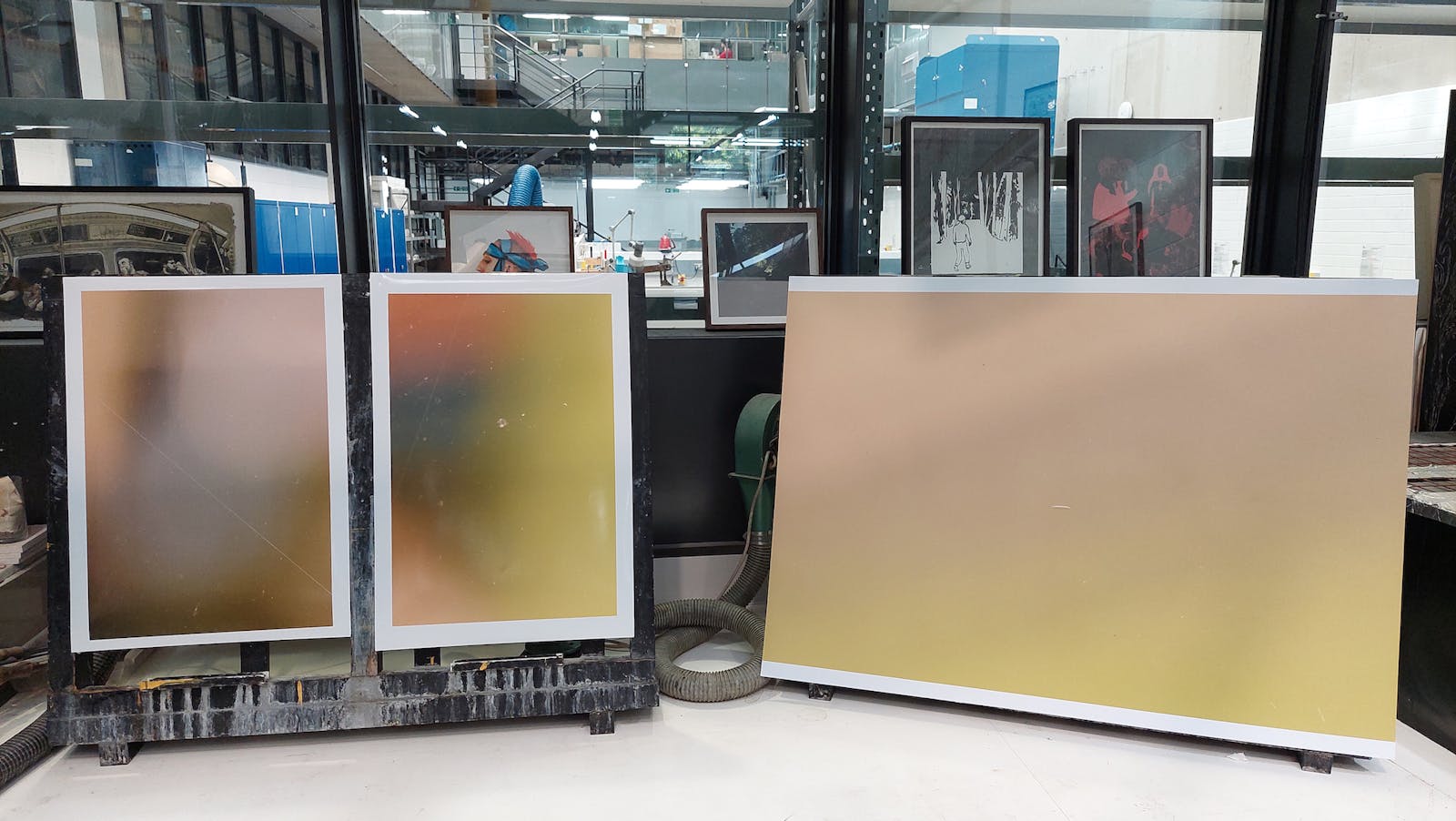
Photographs taken in the print room at the RCA. Left: Glass and dust particles, Size: 60h x 120w cm. Right: Title Bubble. Glass an air bubble in the centre. Size: 60h x 50w cm. Year: 2022/3
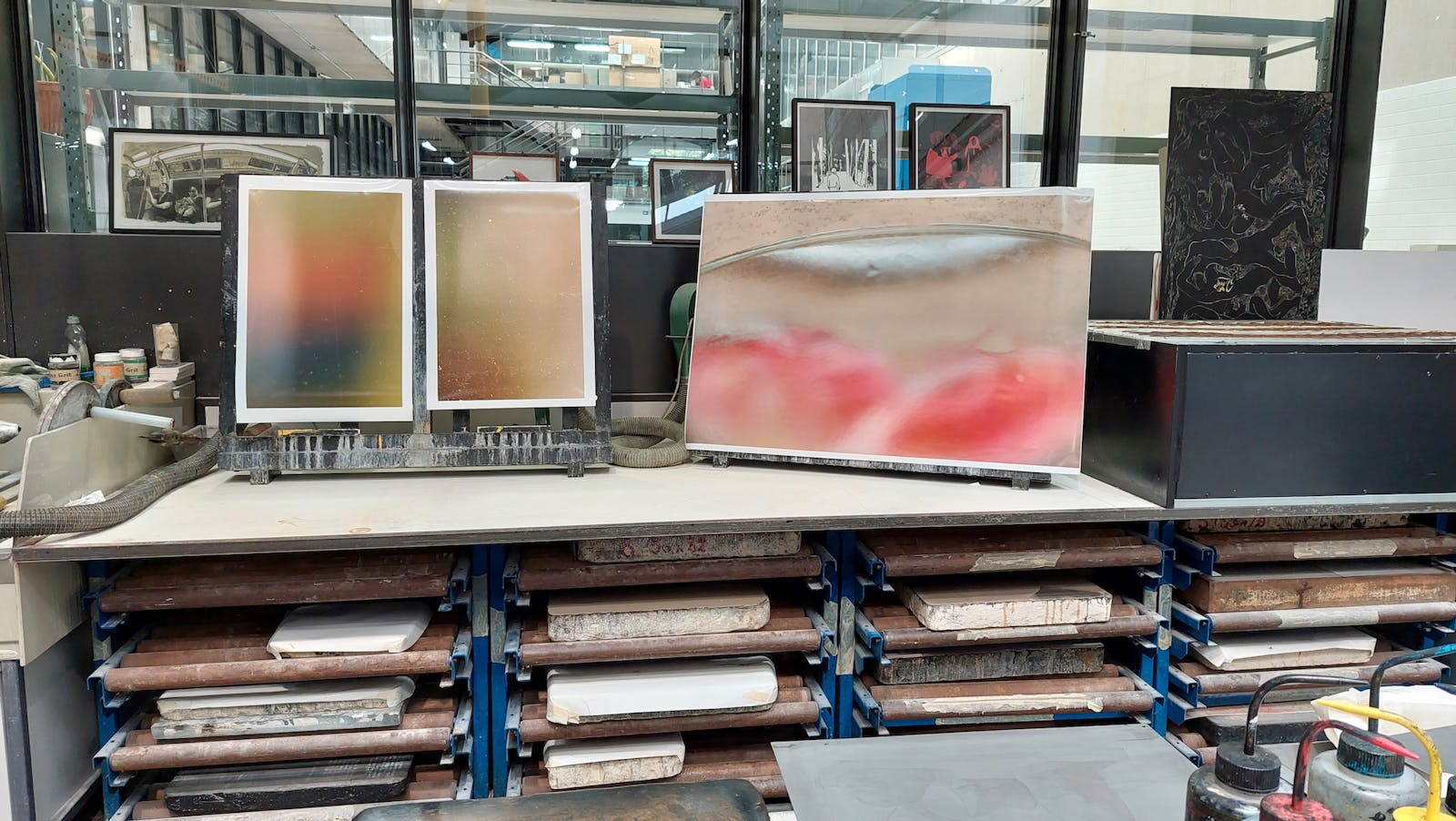
Photographs taken in the print room at the RCA. Left: Glass and dust particles. Size: 60h x 50w cm. Right Titled Held. Description: Forever held in our memory encased in a bubble combined with spent flowers and glass. Size: 80h x 120w cm. Year: 2022

This body of work fuses the foreground colour while observing suspend particles and remnants of dust within the air or fragment of light to draws attention to the unseen. Material: Photograph. Size: 60h x 50w cm. Year 2022
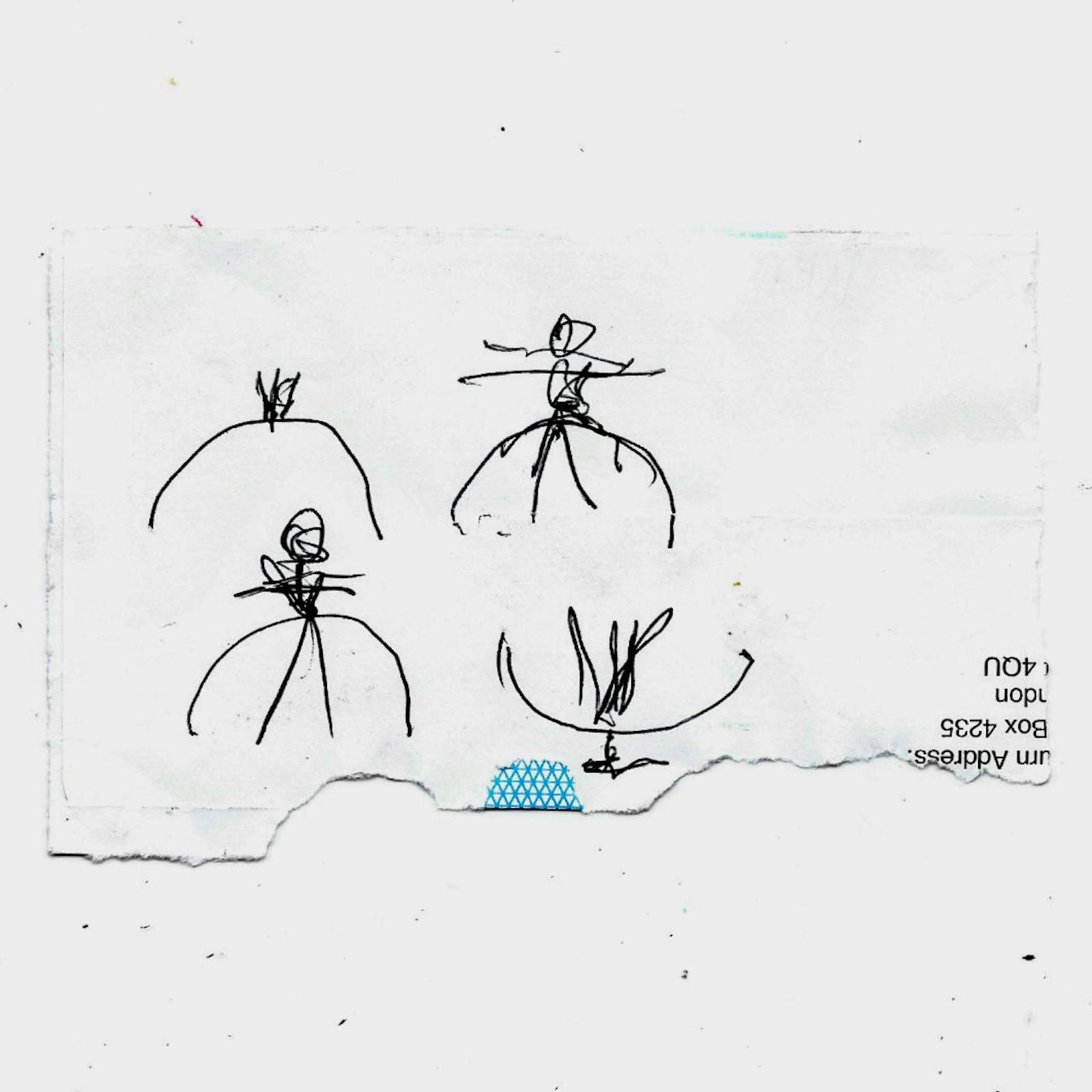
These quick drawings were inspired by the concept of a hooped skirt that relates to the plumed seed as it catches air within its structure. I repurposed my old mail envelopes as note paper and have little stacks of them around the house waiting for my next visual idea or a note to myself. Material: pen on paper. Size: 8h x12w cm. Year: 2020/23
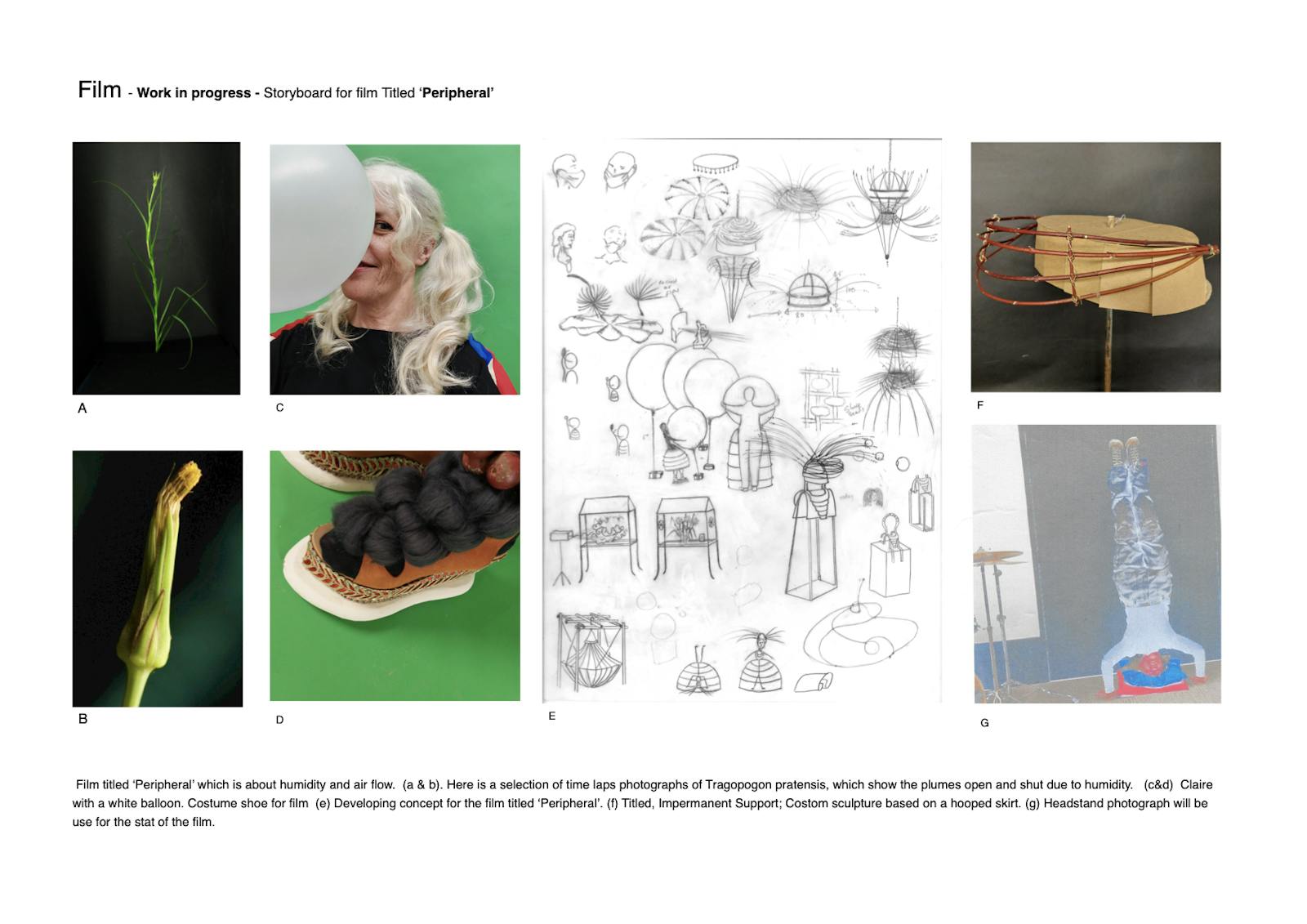
I wanted to observe the action of the plumed seed as it floated, and I turned to film and kinetic sculpture to capture the momentum of the airflow, as an experiment to record the displacement of floating particles. The other factor behind my thinking was sustainability and to try and reduce the resources that I use. And I say ‘try’ because it is not always possible, and I find the mental anxieties that relate to this issue are a mind spin. In this case, I was able to repurpose a pair of shoes for this film, and I made the hooped skirt out of a pair of curtains and left-over willow from the willow sculpture. (a & b) Tragopogon pratensis. (c) A white balloon and myself, (d) Costume shoe for film (e) Developing the concepts for the film titled ‘Peripheral’. (f) Titled Impermanent Support; Costume sculpture based on a hooped skirt. (g) Headstand photograph as an idea for the film. I have been working as the producer and co-director for this film and Laurence Lennard is the director and editor. Year: 2020/23.
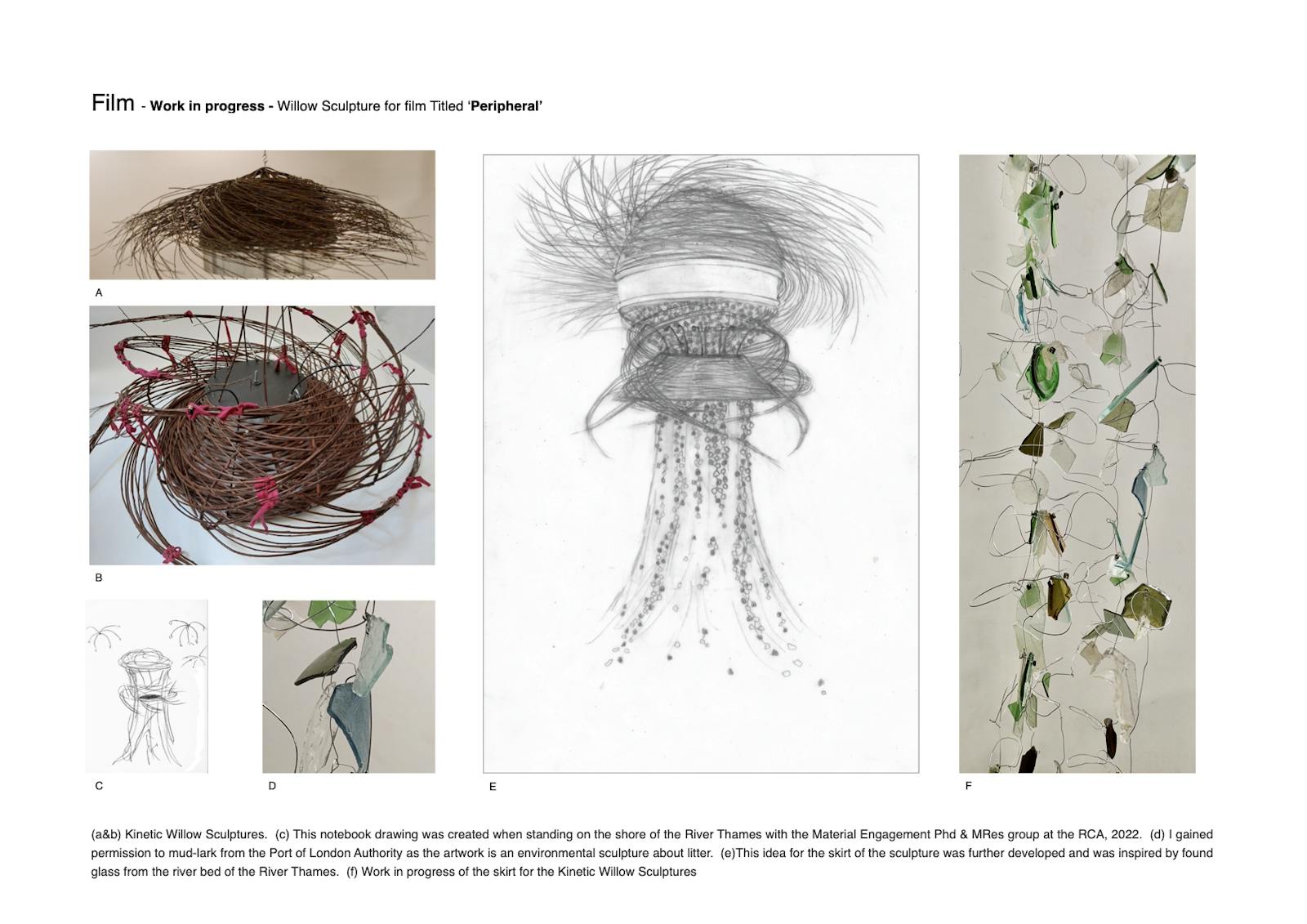
The opening and closing of a plumed seed is determined by the humidity in the air, which I find fascinating, and is the basis of my research. I also look at the movement of air, how it would be to float, what the plumed seed has to float through to touch the ground and the types of environment it would encounter. Year: 2020/23.
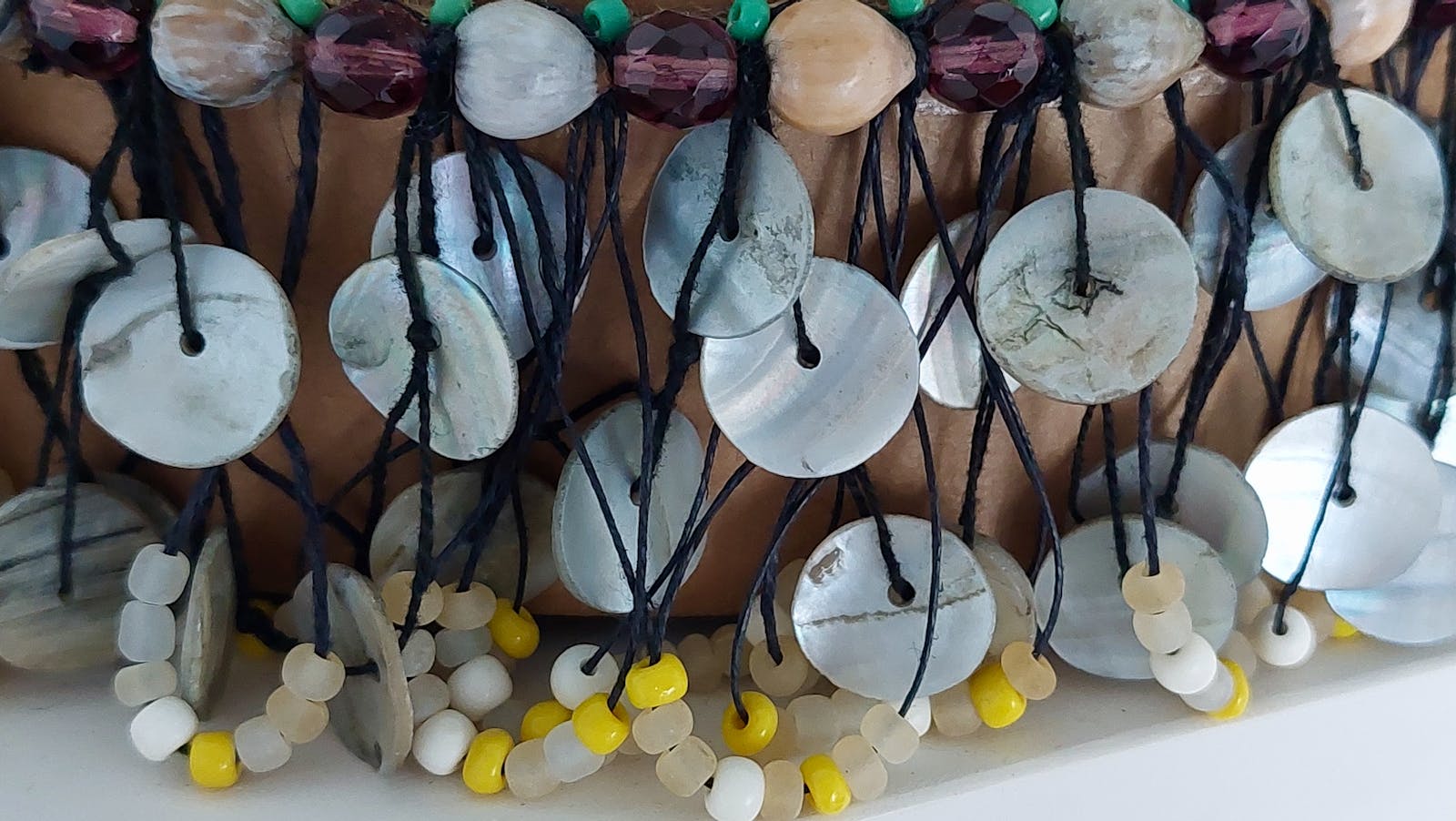
This artwork was exhibited at the Earthwise group exhibition with PhD and MRes, School of Fine Art and Humanities, RCA at the Beaconsfield Gallery, London, 2023. Material: Restored wooden easel, recycled wood, glass demijohn, paper, card, candle, beads and thread. The fringe of the demijohn was hand sewn onto the card from a cereal packet with an adapted necklace of mother-of-pearl.
Size: 31h x 22w cm. Year: 2023
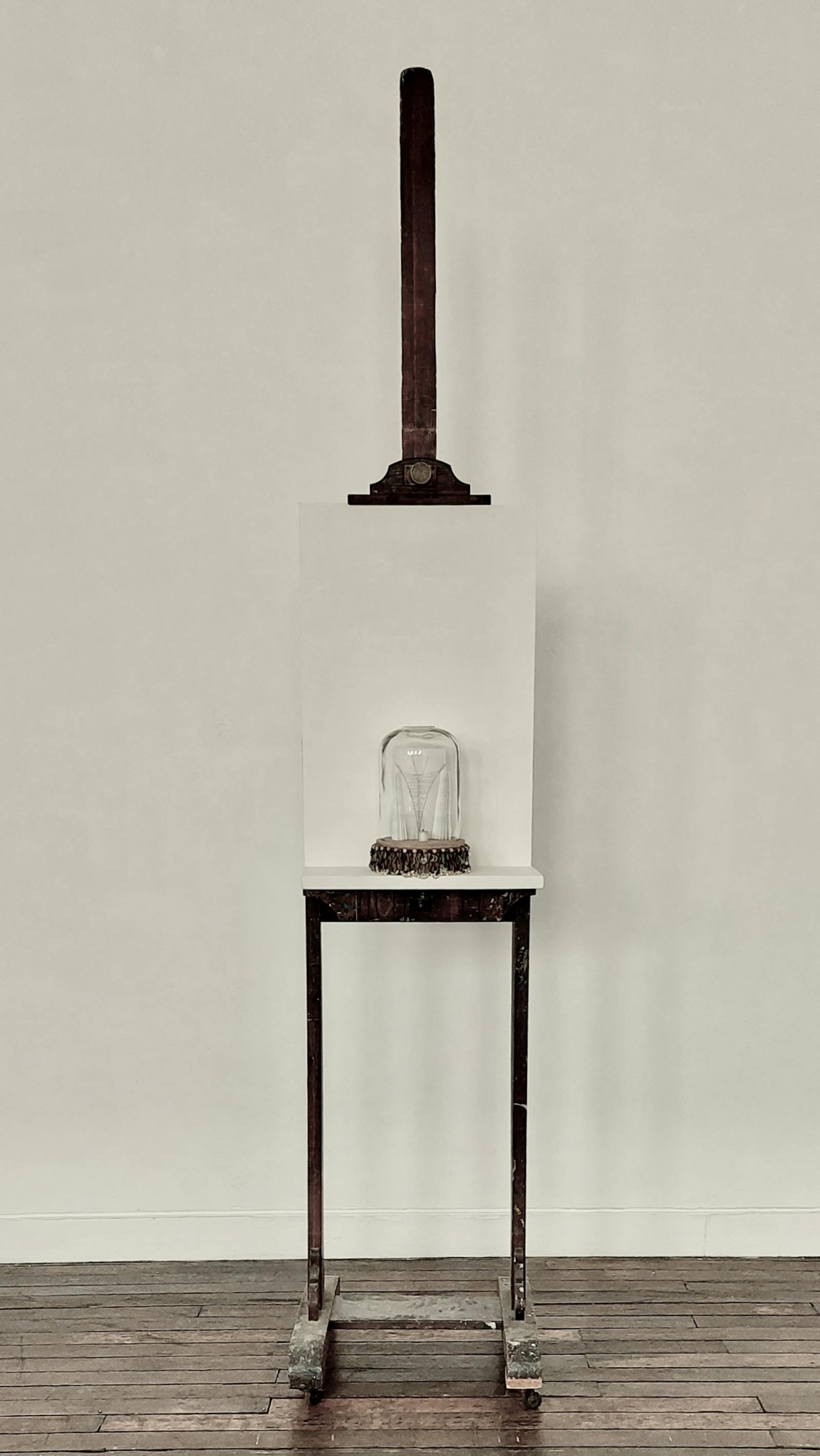
For this artwork, sustainability was embraced by restoring an old college easel with recycled wood while I repurposed a demijohn by removing its neck and base to make the bell jar. Avoiding plastic beads, I chose to buy a variety of necklesses sourced from charity shops that represented London’s multicultural community. These beads were of glass, mother-of-pearl and tear seeds, while the small seed/love beads are made of glass, stone and bone and were bought new for their specific colours and sizes. Material: Wooden easel and gesso board. Size: 182h x 60w x 47d cm. Year: 2023
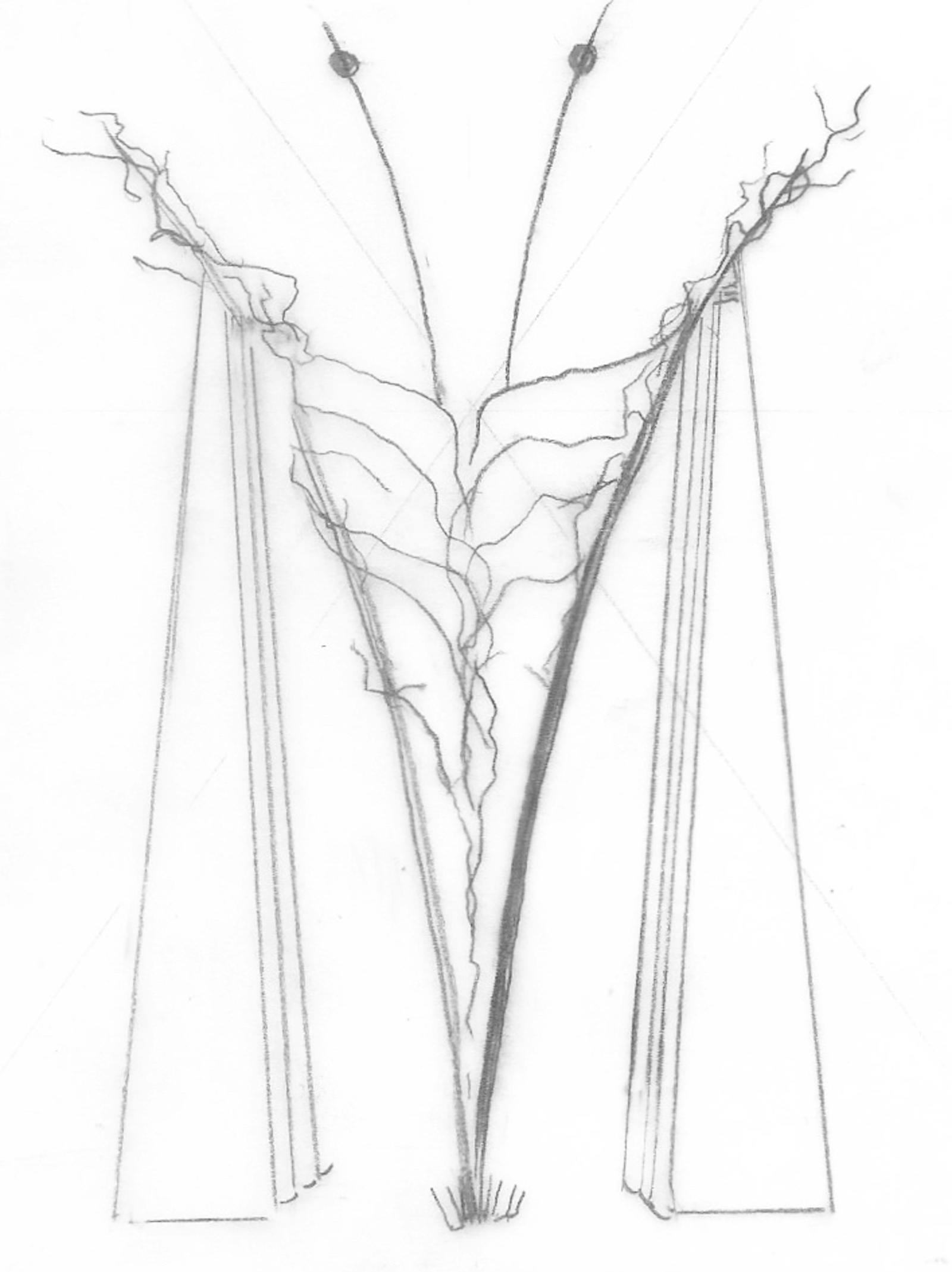
Inspired by the plumed seed of a Tragopogon pratensis L (Salsify), my drawing depicts the intricate interlacing of secondary plumes and spines through a macro lens. The upright triangular book pages hold up the drawing and symbolise the free fall of the seed and the sloping floor of the Beaconsfield Gallery, reflecting the artwork's title. Material: Drawing on paper with pencil showing the secondary plumes which resemble glass as a material to work with. Size: 15h x 8w cm. Year: 2023
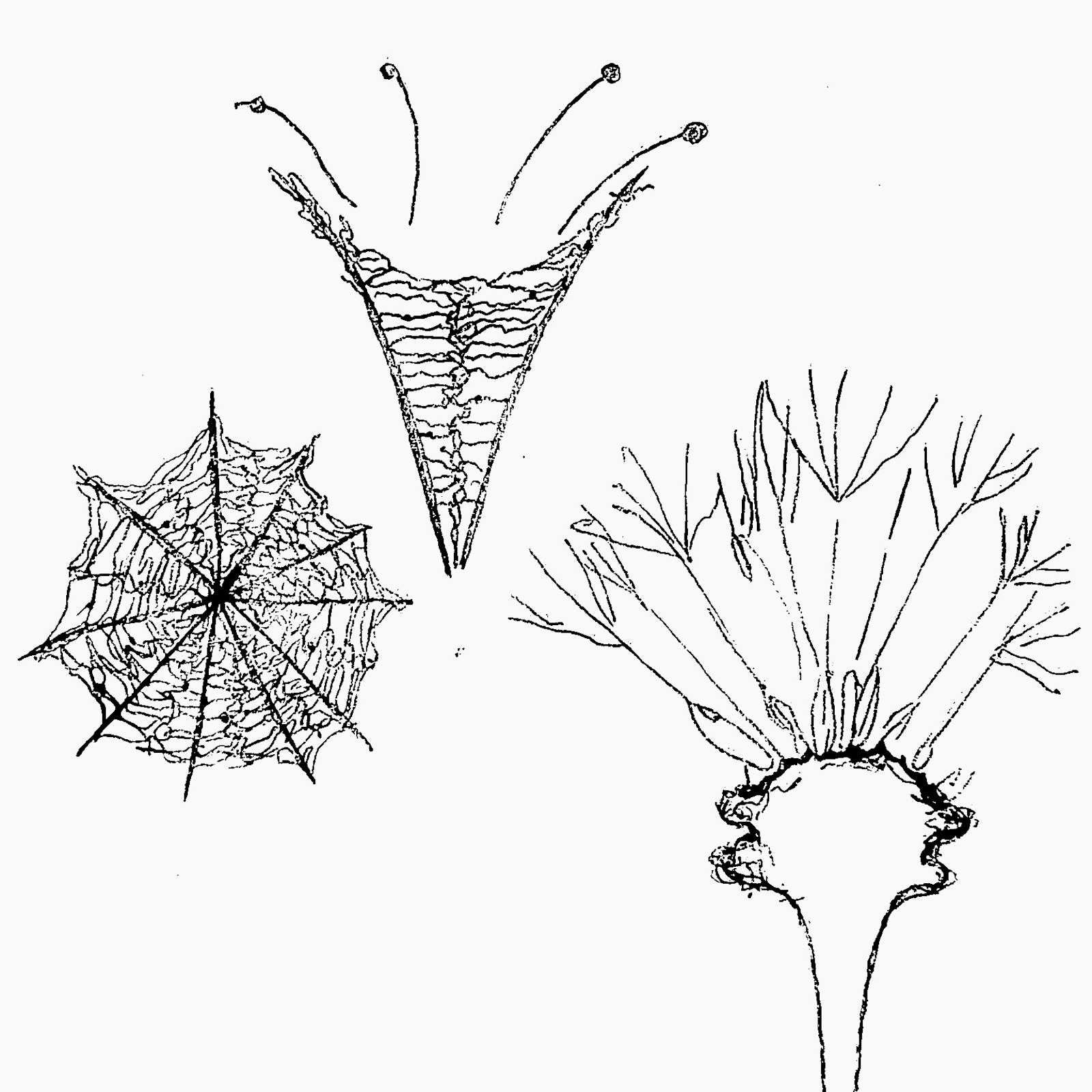
Notebook drawings.
When choosing material I keep sustainability in mind and used tracing paper for this screen print to align my notebook drawings instead of using a plastic sheet. Top middle, a segment of the plumes. This was the drawing that generated this sculpture. Left, viewed from the side. Bottom right, cross section of apical plate, seeds attached to floral podium. Note that the seeds are attached to a beak (stem) and plumes of a Pappus. Material: screen print on paper. Size: 15h x 15w cm. Year: 2023
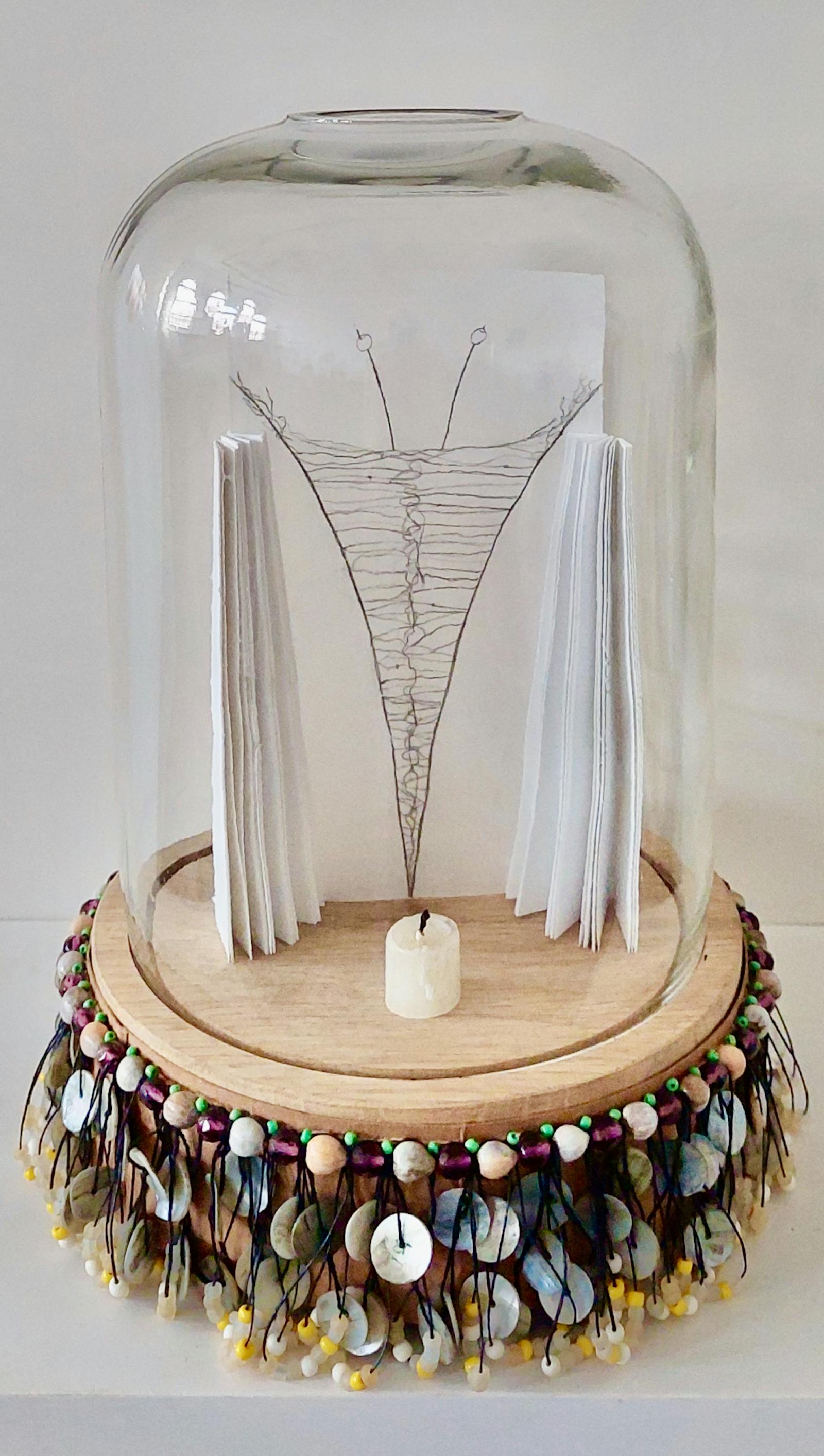
A drawing of the plumed seed segment from a Salsify is held up by triangular uprights, representing book pages. The candle symbolizes Joseph Priestley's discovery that plants produce oxygen as a by-product of photosynthesis (West 2013 L116)*. Priestley experimented by placing a lighted candle in a bell jar to find the candle went out when it had burnt all the air. He then put a plant and a mouse in the bell jar to find that the mouse lived due to the plant creating oxygen for it to live. Material: The fringe of the demijohn was hand sewn onto the card from a cereal packet with the adapted necklaces; recycled wood, recycled demijohn with its neck and bottom removed, paper and thread. Size: Glass demijohn 31h x 22w cm. Year: 2023. *West, J.B. (2013). Oxygen, and the Enlightenment, University of California San Diego.
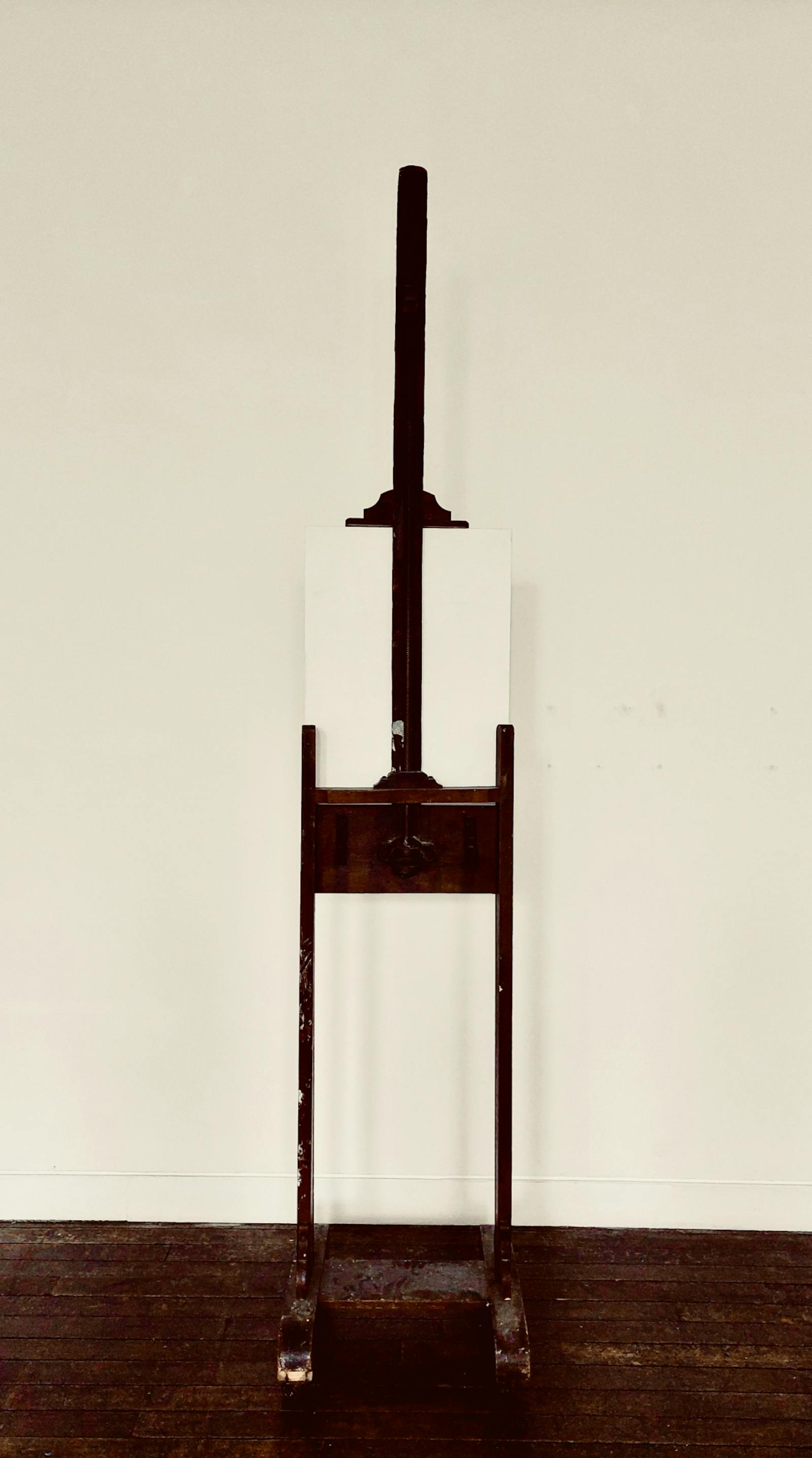
I realised that the essence of this artwork lies in its invisibility when viewing the rear of the easel and gesso board for the first time: its essence lies in the combination of the two objects. Seeing these together for the first time gave me the expectation that there was an artwork there, even if it was not visible, as without the white board the easel was just an easel. This awareness stopped me in my tracks, and I compared this feeling to one of the same intensity as a field sighting. I could see that I was looking at a new dimension to this artwork and this unexpected fluidity of thought brought an insight and comprehension to my artistic quest. Material: Wooden easel and gesso board. Size: 182h x 60w x 47d cm. Year: 2023
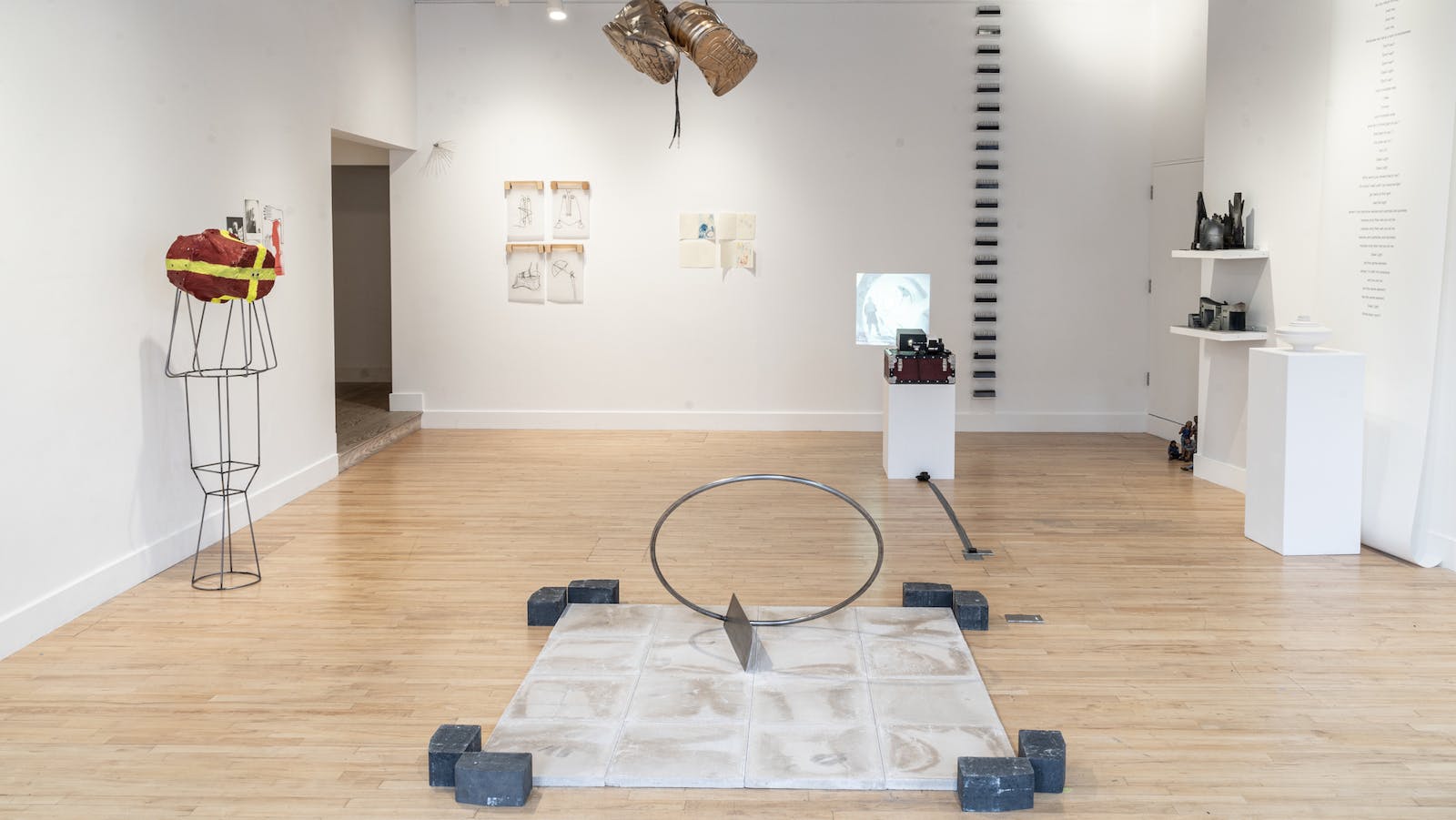
Group Exhibition with MRes, School of Fine Art and Humanities 2023. Cooke Latham Gallery, London.
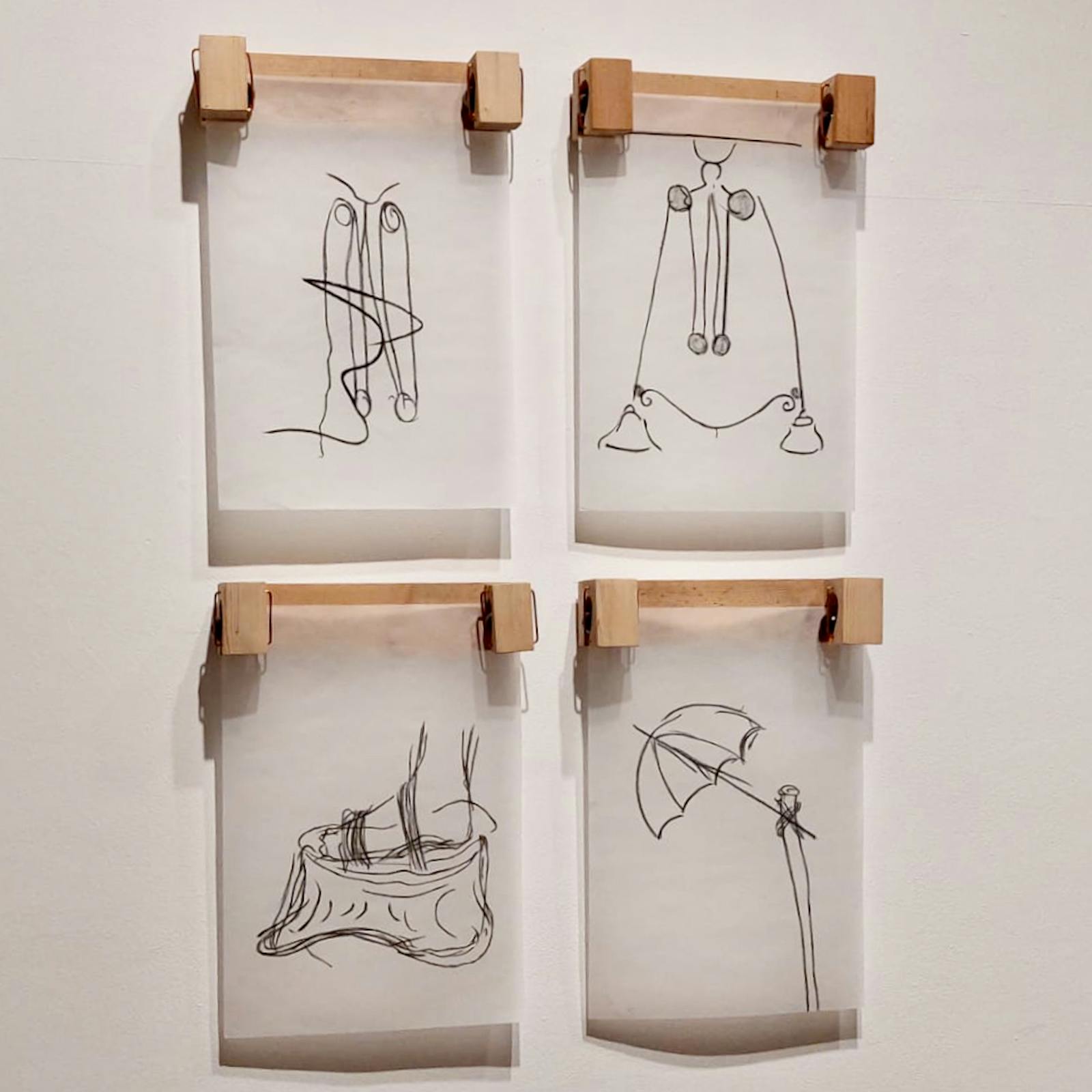
I draw when a spontaneous image forms in my mind, allowing my creativity to flow naturally*, and I reach for my notebook to scribble a thought. Here I have explored the sensation of floating and transitioning into freefall, inspired by plumed seeds. I find inspiration in man-made contraptions like pulleys that suspend objects and allow controlled motion. For instance, I imagine shoes and umbrellas holding their form while in motion. The umbrella becomes a parasol with arms opening at the push of a button, much like the plumed seed's mechanism. Top left: Titled, do it again. Top right: Titled Pulley. Bottom left: Titled, Walking in Mud. Bottom right: Titled, Opened. Size 42h x 29.7w cm. Material: Crayon on tracing paper. Year: 2023. *inspired by, Jack Kerouac’s spontaneous prose.
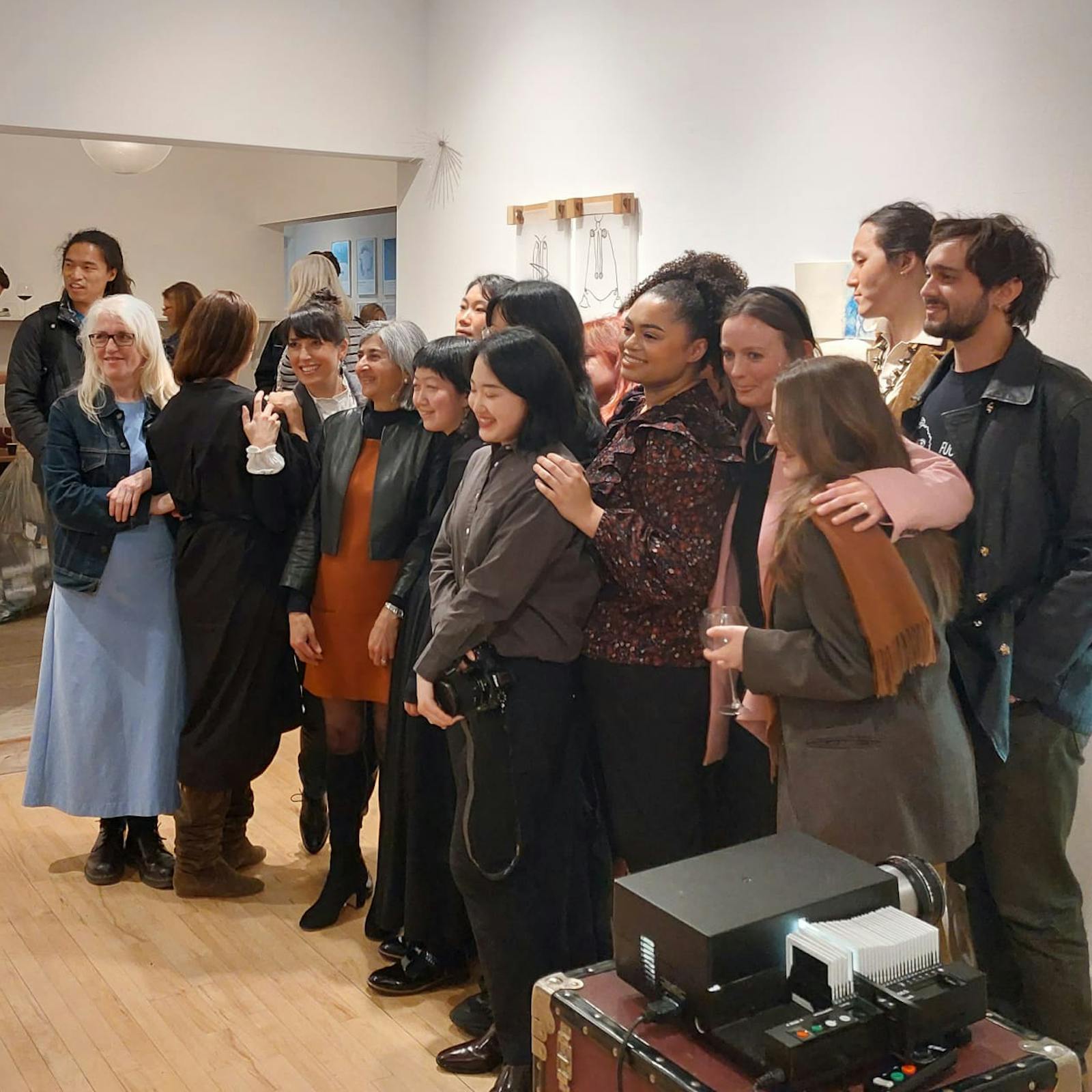
Group exhibition titled Inner Workings. Cohort of MRes, School of Fine Art and Humanities 2023.
